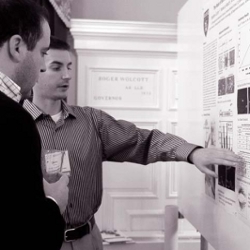 Each year for the past four years, HSCI has invited renowned stem cell scientists to the Tony & Shelly Malkin Symposium to discuss a pivotal area of stem cell research. In past years, the Symposium has addressed topics as varied as reprogramming and pluripotency, and stem cell biology and therapy in organ systems. This past fall, the Malkin Symposium brought together an experienced panel of scientists to discuss research developments related to the cancer stem cell.
Each year for the past four years, HSCI has invited renowned stem cell scientists to the Tony & Shelly Malkin Symposium to discuss a pivotal area of stem cell research. In past years, the Symposium has addressed topics as varied as reprogramming and pluripotency, and stem cell biology and therapy in organ systems. This past fall, the Malkin Symposium brought together an experienced panel of scientists to discuss research developments related to the cancer stem cell.
The cancer stem cell hypothesis is based on mounting evidence that at the heart of many cancers is a core of stem cells whose normal, helpful contributions to tissue maintenance and repair are hijacked by mutations. Often cancer stem cells are different enough from most tumor cells that they aren’t vulnerable to current chemotherapy and their survival allows a cancer to return and spread.
Moderating this year’s symposium were Jerome Ritz, an HSCI Faculty Executive Committee member from the Dana Farber Cancer Institute, and Gary Gilliland, Director of HSCI’s Cancer Program, and Professor of Medicine at Brigham and Women’s Hospital and Harvard Medical School. “The topic represents an important intersection between stem cell research and cancer research,” said Ritz. “These are two important fields and the conference brought together different groups of investigators within the Harvard community who could interact and learn from each other. Importantly, the speakers presented new and exciting results that were directly relevant to the future development of new and more effective therapies.”
John Dick of the University of Toronto, who isolated the first leukemia initiating cells, began with a theme that emphasized the ambiguity of this field: “Heterogeneity, heterogeneity, heterogeneity!” In other words, no one set of molecular markers identifies cancer stem cells. Instead, according to Dick, researchers must rely on functional assays, where cells are isolated and then transplanted into mice to see if they are capable of causing a tumor.
Other speakers probed the molecular biology of cancer-inducing cells. Owen Witte, of the University of California at Los Angeles, described the linking of his transplant assay with data on the cellular pathways active in prostate cancer to identify possible stem cells. Scott Armstrong, an HSCI principal faculty member at Children’s Hospital Boston, discussed his research on how chromosomal translocations perturb a cell’s normal life cycle, directing it into a cancer-producing state. In the case of breast cancer, heterogeneity rules once again, whether in the array of surface markers found on possible cancer stem cells or in changes in those markers. Kornelia Polyak, of the Dana Farber Cancer Institute, described a more differentiated cancer precursor cell that can follow more than one lineage.
 Among the day’s speakers, Peter Dirks, also of the University of Toronto, who combines transplant assays with surface marker labeling to find possible brain cancer stem cells, presented the most progress toward an anti-cancer therapy based on the stem cell model. Noting similarities between normal neural stem cells and his proposed cancer stem cells, Dirks has moved into a search for new therapies. A screening process that began with about 5,000 drugs has narrowed to five promising candidates. If the cancer stem cell theory holds, drugs like these, combined with current chemotherapy, may be able to eradicate a patient’s cancer.
Among the day’s speakers, Peter Dirks, also of the University of Toronto, who combines transplant assays with surface marker labeling to find possible brain cancer stem cells, presented the most progress toward an anti-cancer therapy based on the stem cell model. Noting similarities between normal neural stem cells and his proposed cancer stem cells, Dirks has moved into a search for new therapies. A screening process that began with about 5,000 drugs has narrowed to five promising candidates. If the cancer stem cell theory holds, drugs like these, combined with current chemotherapy, may be able to eradicate a patient’s cancer.
The scientific talks, along with a well attended poster session, represented the wide range of research being conducted in this field. The theme of the day was also addressed in an evening dinner keynoted by Jeffrey Flier, Dean of the Harvard Medical School. Dean Flier discussed the institutional heterogeneity that both challenges and enriches scientific and clinical pursuits. “People across the University are working together to get therapies,” said Flier. “The Harvard Stem Cell Institute and the Department of Stem Cell and Regenerative Biology are real living examples of how Harvard sees the future of science and medicine.”
